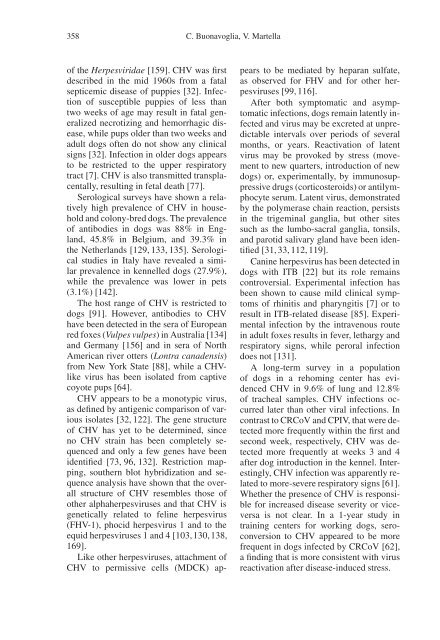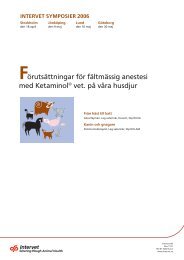KVÄLLSSYMPOSIUM 2008 Vaccinering av hund och katt
KVÄLLSSYMPOSIUM 2008 Vaccinering av hund och katt
KVÄLLSSYMPOSIUM 2008 Vaccinering av hund och katt
Create successful ePaper yourself
Turn your PDF publications into a flip-book with our unique Google optimized e-Paper software.
358 C. Buon<strong>av</strong>oglia, V. Martella<br />
of the Herpesviridae [159]. CHV was first<br />
described in the mid 1960s from a fatal<br />
septicemic disease of puppies [32]. Infection<br />
of susceptible puppies of less than<br />
two weeks of age may result in fatal generalized<br />
necrotizing and hemorrhagic disease,<br />
while pups older than two weeks and<br />
adult dogs often do not show any clinical<br />
signs [32]. Infection in older dogs appears<br />
to be restricted to the upper respiratory<br />
tract [7]. CHV is also transmitted transplacentally,<br />
resulting in fetal death [77].<br />
Serological surveys h<strong>av</strong>e shown a relatively<br />
high prevalence of CHV in household<br />
and colony-bred dogs. The prevalence<br />
of antibodies in dogs was 88% in England,<br />
45.8% in Belgium, and 39.3% in<br />
the Netherlands [129, 133, 135]. Serological<br />
studies in Italy h<strong>av</strong>e revealed a similar<br />
prevalence in kennelled dogs (27.9%),<br />
while the prevalence was lower in pets<br />
(3.1%) [142].<br />
The host range of CHV is restricted to<br />
dogs [91]. However, antibodies to CHV<br />
h<strong>av</strong>e been detected in the sera of European<br />
red foxes (Vulpes vulpes) in Australia [134]<br />
and Germany [156] and in sera of North<br />
American river otters (Lontra canadensis)<br />
from New York State [88], while a CHVlike<br />
virus has been isolated from captive<br />
coyote pups [64].<br />
CHV appears to be a monotypic virus,<br />
as defined by antigenic comparison of various<br />
isolates [32, 122]. The gene structure<br />
of CHV has yet to be determined, since<br />
no CHV strain has been completely sequenced<br />
and only a few genes h<strong>av</strong>e been<br />
identified [73, 96, 132]. Restriction mapping,<br />
southern blot hybridization and sequence<br />
analysis h<strong>av</strong>e shown that the overall<br />
structure of CHV resembles those of<br />
other alphaherpesviruses and that CHV is<br />
genetically related to feline herpesvirus<br />
(FHV-1), phocid herpesvirus 1 and to the<br />
equid herpesviruses 1 and 4 [103,130,138,<br />
169].<br />
Like other herpesviruses, attachment of<br />
CHV to permissive cells (MDCK) ap-<br />
pears to be mediated by heparan sulfate,<br />
as observed for FHV and for other herpesviruses<br />
[99, 116].<br />
After both symptomatic and asymptomatic<br />
infections, dogs remain latently infected<br />
and virus may be excreted at unpredictable<br />
intervals over periods of several<br />
months, or years. Reactivation of latent<br />
virus may be provoked by stress (movement<br />
to new quarters, introduction of new<br />
dogs) or, experimentally, by immunosuppressive<br />
drugs (corticosteroids) or antilymphocyte<br />
serum. Latent virus, demonstrated<br />
by the polymerase chain reaction, persists<br />
in the trigeminal ganglia, but other sites<br />
such as the lumbo-sacral ganglia, tonsils,<br />
and parotid salivary gland h<strong>av</strong>e been identified<br />
[31, 33, 112, 119].<br />
Canine herpesvirus has been detected in<br />
dogs with ITB [22] but its role remains<br />
controversial. Experimental infection has<br />
been shown to cause mild clinical symptoms<br />
of rhinitis and pharyngitis [7] or to<br />
result in ITB-related disease [85]. Experimental<br />
infection by the intr<strong>av</strong>enous route<br />
in adult foxes results in fever, lethargy and<br />
respiratory signs, while peroral infection<br />
does not [131].<br />
A long-term survey in a population<br />
of dogs in a rehoming center has evidenced<br />
CHV in 9.6% of lung and 12.8%<br />
of tracheal samples. CHV infections occurred<br />
later than other viral infections. In<br />
contrast to CRCoV and CPIV, that were detected<br />
more frequently within the first and<br />
second week, respectively, CHV was detected<br />
more frequently at weeks 3 and 4<br />
after dog introduction in the kennel. Interestingly,<br />
CHV infection was apparently related<br />
to more-severe respiratory signs [61].<br />
Whether the presence of CHV is responsible<br />
for increased disease severity or viceversa<br />
is not clear. In a 1-year study in<br />
training centers for working dogs, seroconversion<br />
to CHV appeared to be more<br />
frequent in dogs infected by CRCoV [62],<br />
a finding that is more consistent with virus<br />
reactivation after disease-induced stress.





